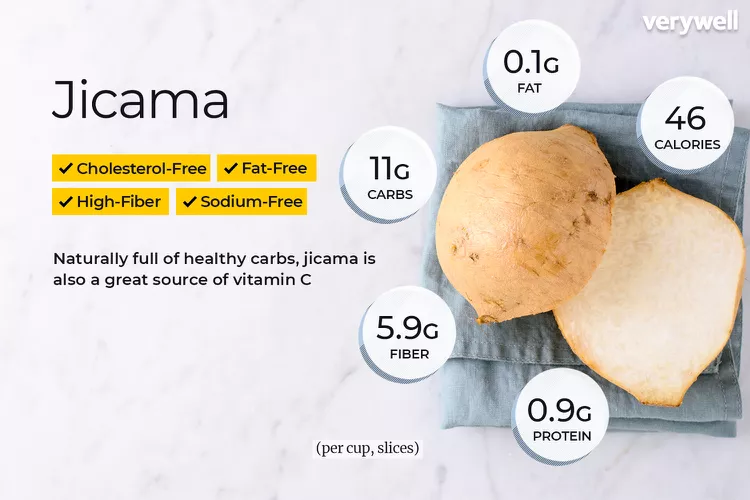Jicama is a tuber that looks like a potato. It has a thick, brown skin, and a white, crispy, juicier flesh. Jicama roots are also known as Mexican potato, Mexican jam bean or Mexican turnip. While jicama can be enjoyed raw, it is also a great addition to recipes. Jicama is a great low-carb substitute for water chestnuts.
Jicama Diet Info
USDA offers the following diet data for 1 cup of jicama uncooked slices.
Energy: 46
Fats: 0.1g
Sodium: 5.2mg
Carbohydrates: 11g
Fiber: 5.9g
Sugars: 2.2g
Protein: 0.9g
Carbs
Jicama provides a good source of carbohydrates. One cup of Jicama contains three different types of carbohydrates.
Fiber: about 6 grams
Sugar: About 2 grams naturally occurring sugar
Starch: about 3 grams
Jicama is regarded as a low-glycemic food due to its high fiber content. This vegetable has a glycemic index of approximately 10. The glycemic index also takes into account the portion size of the meal. It is believed that a glycemic index of less than 10 has little effect on blood glucose levels.
It is a good idea to use
Jicama has a low fat content, with less than 1 gram per serving of mostly polyunsaturated fatty acids. If you choose polyunsaturated fats over saturated fats, they are considered “good” fats because they promote heart health.
Protein
Jicama may only have a tiny quantity of protein. If you consume 2,000 calories per day, a serving of jicama will only provide 2% your daily protein needs.
Vitamins and minerals for nutrition
Jicama contains a good amount of vitamin C, also known as L-ascorbic Acid. One serving contains 24 milligrams, or about 40% of what you need every day. Vitamin C cannot be synthesized by our bodies, so it is vital to consume foods rich in vitamin C for healthy bone, cartilage and muscle. Vitamin C also aids in the absorption iron and promotes wound healing.
Jicama contains a small amount of vitamin E (0.66 milligrams, or 4% of the RDI), folate (4 % of RDI), Vitamin B6 (3 % of RDI), thiamin (2% each), riboflavin (2%), and pantothenic (2%).
Jicama also offers potassium. A single serving contains 195 milligrams or about 6% your daily needs. Other minerals that jicama offers include:
Iron (4% RDI).
Magnesium (4 % of RDI).
Copper (3% RDI).
Phosphorus (2 % of RDI).
Calcium (2% RDI).
Zinc (1% RDI).
Well being Advantages
The jicama’s high fiber content and vitamin C concentration are its most important benefits.
Reduces the Risk of Illness
Fiber is beneficial to your health in many ways. Fiber is not only good for digestion, but it also has many other health benefits, including a reduced risk of certain types of cancer, diabetes, and heart disease.
Vitamin C is a powerful antioxidant. Vitamin C is an antioxidant.
Promotes Good Micro organism
Prebiotic fibers in jicama, which are fermentable, contribute to a healthy intestine microbiome. This is the colony or “good” bacteria within the digestive system.
Allergic reactions
If you experience allergy symptoms, such as itching and swelling around the mouth after eating jicama then seek medical advice to diagnose and treat your condition.
Hostile Results
While the flesh of the jicama can be eaten, other parts of the plant may not be safe for humans or animals to consume. The seeds and stems of jicama contain a naturally-occurring compound used to kill fish and as an insecticide. Rotenone is a poisonous compound.
Rotenone can cause vomiting, muscle tremors and convulsions in animals. Cardiovascular effects include tachycardia, hypotension and even death. While people may not experience signs as extreme when exposed to small portions of yam beans or jicama plants, it is best to avoid consuming other parts of the plant.
Variety
Jicama comes in two main varieties. Jicama de agua, or jicama de agua as it is also known, is mainly grown and consumed in the United States. It has a large spherical roots and juices that are clear. Jicama de leche is a root that’s extra-long and has milky white juice.
When It’s Finest
You can buy jicama at your local market all year round, but it is best to purchase between October and February. Look for jicama with a smooth skin that is heavy for its size. Choose a medium-sized veggie, as larger ones tend to be less flavorful.
Storage and Meals Security
When stored in the refrigerator, jicama should stay fresh for two weeks. Cover any exposed areas with plastic wrap in order to reduce air exposure (though jicama will not turn brown when exposed to air like other fruits and vegetables can).
How to put together the best possible way
Remove the jicama’s thick brown skin with a vegetable peeler or paring knife before eating or cooking. Although jicama looks like a potato but tastes like an apple, it is actually a variety of savory. It has a crunchy texture and a nutty flavor.
Slice jicama and enjoy it raw. It can be added to a crudite plate or eaten like a carrot. Dip it in hummus, salsa or another savory dip to enjoy this root vegetable. Use jicama to top salads, coleslaw or this Asian shrimp dish. Add jicama to salsa along with black beans and corn or stuff it into spring rolls.
Jicama tastes great uncooked but it can also be prepared. Try adding jicama into your favorite stir-fry, or sautéing it with onions and peppers to give a new twist on house fries or hash browns. Use as you would potato or water chestnut.


